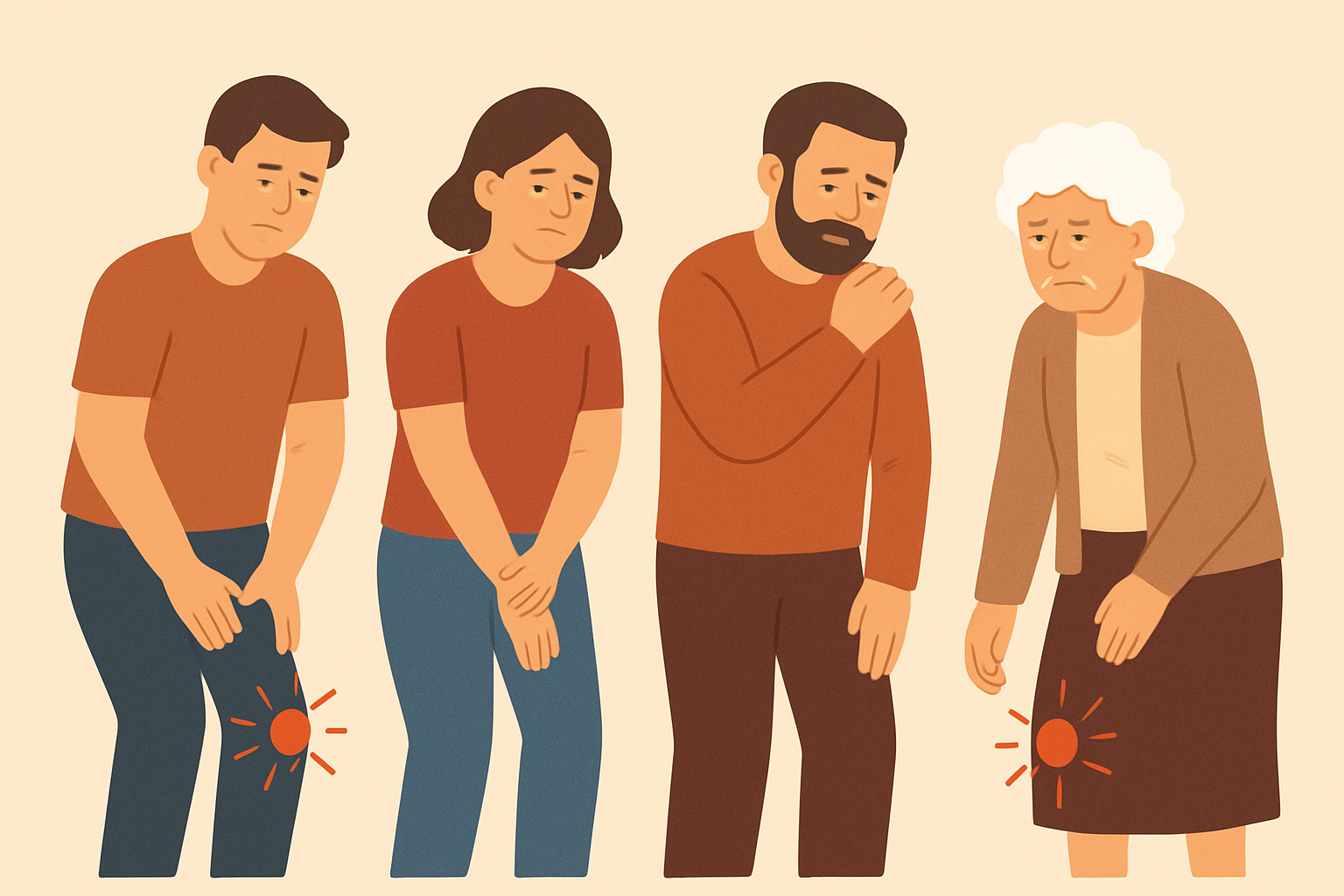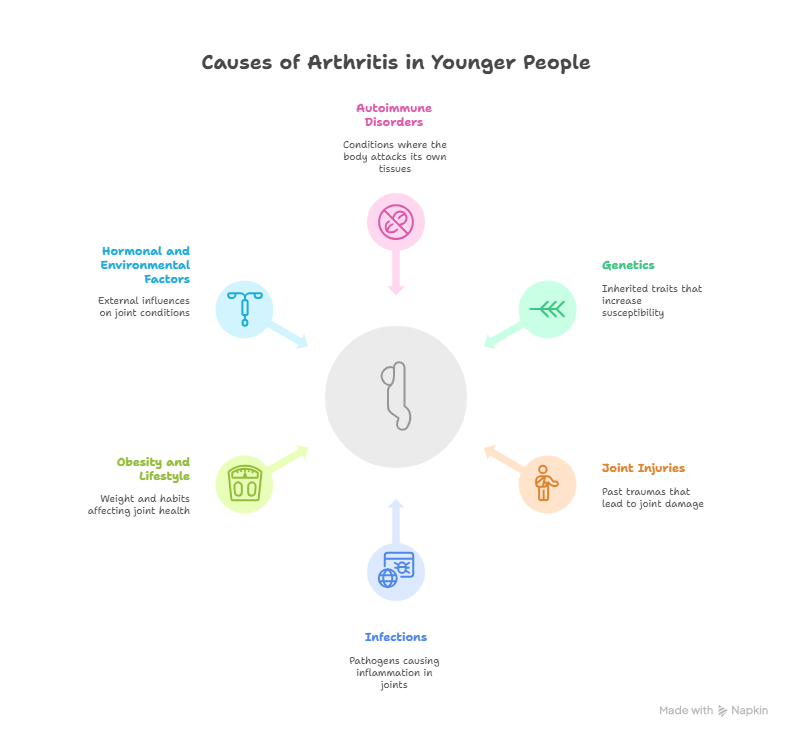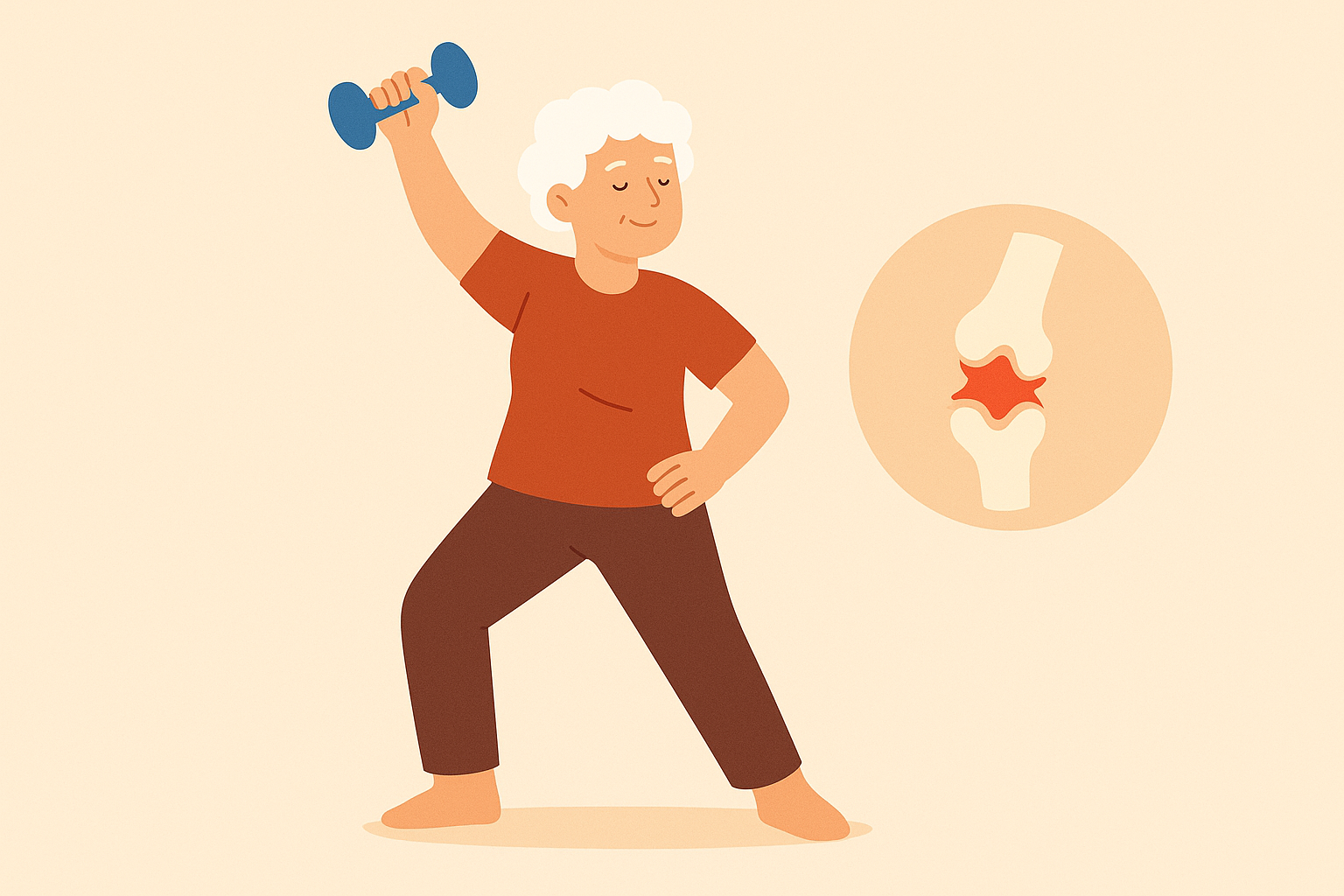
When most people hear the word arthritis, they immediately picture aching joints, grey hair, and walking canes. It’s a common image, but also a misleading one. While arthritis is indeed more common with age, it’s far from being an “old person’s disease.” In reality, Arthritis in Young Age is becoming an increasingly recognised health concern, affecting people in their 20s, 30s, and even teenagers.
Modern research has uncovered that many forms of arthritis stem not just from wear and tear but from complex factors like genetics, autoimmune disorders, injuries, and even lifestyle influences. In fact, more than 350 million people worldwide live with some form of arthritis, and millions of them are under 40.
In this article, we’ll break down the myth that arthritis only affects the elderly, explore why younger people develop it, and discuss what Arthritis in Young Age really means for your long-term health, mobility, and everyday life.
The Myth: “Arthritis Only Happens to Older Adults”
This myth likely persists because the most visible form of arthritis, osteoarthritis (OA), is associated with ageing. As people get older, years of joint use naturally wear down cartilage, leading to stiffness and pain. However, this is just one type of arthritis.
There are over 100 different types of arthritis, and many of them have nothing to do with age. For example:
Rheumatoid arthritis (RA) is an autoimmune condition that can strike at any age—even during childhood.
Juvenile idiopathic arthritis (JIA) affects children under 16.
Psoriatic arthritis (PsA) can develop in young adults with psoriasis.
Ankylosing spondylitis (AS) often starts in the late teens or twenties, affecting the spine and hips.
So while age can be a factor, it’s far from the whole story. Arthritis is a complex condition that can begin long before grey hair appears.
Understanding Early-Onset Arthritis
Early-onset arthritis refers to any form of arthritis that appears before the age of 40. It may develop gradually or suddenly, often catching people off guard. Unlike age-related arthritis, early-onset types usually involve autoimmune reactions, genetics, or injuries that trigger inflammation in the joints.
Some people experience mild, intermittent joint pain, while others face severe symptoms that disrupt daily life, sleep, and work. Unfortunately, because arthritis is commonly thought of as an older person’s issue, younger patients often go undiagnosed or misunderstood for years.
What Is Juvenile Arthritis?
While many people think of joint disease as an adult problem, the fact is that children and teens can develop what is often called Juvenile Arthritis—a group of inflammatory conditions that begin before age 16 and affect more than one in 300 young people in the U.S. alone – stayhealthybc
Juvenile arthritis is not a minor or temporary issue: in many cases it lasts for years, and early diagnosis is key to preventing long-term joint damage and supporting full, active lives for affected children and adolescents
Juvenile Idiopathic Arthritis (JIA)
Juvenile Idiopathic Arthritis (JIA) is the most common form of chronic arthritis in children under 16, characterised by persistent joint pain, swelling and stiffness lasting at least six weeks. – niams.nih.gov
It is considered an autoimmune-driven disease in which a child’s immune system attacks healthy joint tissues, and the exact cause remains unknown. PubMed
Early diagnosis and aggressive treatment aim to control inflammation, preserve joint function, promote normal growth and development, and allow the child to participate fully in school, sports and everyday life. niams.nih.gov
Causes of Arthritis in Younger People
1. Autoimmune Disorders
Autoimmune arthritis happens when the immune system mistakenly attacks healthy joint tissue. This leads to inflammation, pain, and stiffness.
Conditions like rheumatoid arthritis, psoriatic arthritis, and lupus-related arthritis are examples. These conditions can strike in one’s 20s or 30s and may flare up unpredictably.
2. Genetics
Family history plays a big role. If a parent or close relative has arthritis, your risk increases—especially for autoimmune forms like RA or ankylosing spondylitis. Genes linked to the immune system, such as HLA-B27, are known to contribute to early-onset arthritis.
3. Previous Joint Injuries
Sports injuries, accidents, or repetitive strain can damage cartilage and make joints more prone to arthritis later—even in young adults. This is often called post-traumatic arthritis and can develop years after the initial injury.
4. Infections
Certain bacterial or viral infections can trigger reactive arthritis, which causes inflammation in the joints after an infection elsewhere in the body—often in the urinary tract or intestines. It typically affects young adults and can persist for months or longer.
5. Obesity and Lifestyle
Carrying extra weight puts more pressure on joints like the knees and hips, increasing the risk of early cartilage breakdown. Sedentary lifestyles and poor diets can also contribute to inflammation, accelerating the onset of arthritis symptoms.
6. Hormonal and Environmental Factors
Women are more likely than men to develop autoimmune arthritis, and hormonal changes may be part of the reason. Additionally, factors like smoking, stress, and exposure to pollutants can influence immune system function and joint health.

Signs and Symptoms to Watch For Arthritis in Young Age
Because arthritis can look different depending on the type, symptoms may vary. However, some early warning signs are common across forms of arthritis:
Persistent joint pain or stiffness, even after rest
Swelling or warmth in joints
Morning stiffness lasting longer than 30 minutes
Fatigue or feeling generally unwell
Reduced range of motion or difficulty performing daily tasks
If you experience these symptoms, especially if they persist for more than a few weeks, it’s important to consult a healthcare professional. Early diagnosis can make a huge difference in managing symptoms and preventing long-term joint damage.
Impact on Young Adults and Teens
Arthritis in Young Age can be emotionally and socially challenging. Teens and young adults living with joint pain often face fatigue, stiffness, and limited mobility—all while trying to balance studies, careers, and an active lifestyle. For many, Arthritis in young age also brings invisible struggles, such as fluctuating pain and the frustration of being misunderstood.
Young people with Arthritis in their teenage or early adulthood often report feelings of isolation or self-doubt, as peers and even healthcare providers may overlook or misjudge their symptoms. This emotional toll highlights the urgent need for more awareness, early recognition, and empathy toward arthritis across all age groups.
The good news? With modern treatments, supportive communities, and informed lifestyle management, people experiencing Arthritis in Young Age can still lead full, active, and meaningful lives — proving that arthritis is a challenge, not a limitation.
Managing Early-Onset Arthritis
While there is no single cure for arthritis, early management can significantly improve outcomes.
1. Medical Treatments
Doctors may prescribe medications to reduce inflammation and pain, or to slow down immune system attacks in autoimmune forms. These may include:
NSAIDs (nonsteroidal anti-inflammatory drugs)
DMARDs (disease-modifying antirheumatic drugs)
Biologic therapies
Corticosteroids for short-term flare control
2. Physical Therapy and Exercise
Targeted exercise can strengthen muscles around joints, improve flexibility, and reduce pain. Physical therapists can design safe, joint-friendly workouts tailored to individual needs.
3. Weight and Diet Management
Maintaining a healthy weight reduces strain on joints, while an anti-inflammatory diet rich in omega-3s, fruits, vegetables, and whole grains can support joint health. Avoiding processed foods and excess sugar can also help minimise inflammation.
4. Mental Health and Support
Living with chronic pain can take a psychological toll. Support groups, counselling, and mindfulness techniques can help individuals manage the emotional aspects of early-onset arthritis.
5. Lifestyle Adjustments
Small daily habits—like using ergonomic tools, pacing activities, and prioritising rest—can make a big difference in managing discomfort and preserving mobility.
Final Thought on Arthritis in Young Age
Arthritis in a Young Age reminds us that joint pain doesn’t follow a calendar. It doesn’t discriminate by age; it’s not a condition reserved for grandparents anymore; it’s a reality that can touch anyone, from teenagers to thirty-somethings. The key lies in awareness, early diagnosis, and proactive management.
By understanding the many causes of Arthritis in Young Age, whether genetic, autoimmune, or injury-related, we can break the stereotype and empower younger people to take control of their joint health. With the right care, mindful lifestyle choices, and consistent support, living well with arthritis isn’t just possible, it’s the new normal for a more informed, resilient generation.
FAQs on Arthritis in Young Age
1. Can someone in their 20s really get arthritis?
Yes. Many types of arthritis, especially autoimmune forms like rheumatoid arthritis or psoriatic arthritis, can appear in young adults. Even injuries or infections can trigger arthritis at a young age.
2. How is early-onset arthritis diagnosed?
Doctors use a combination of medical history, physical exams, blood tests, and imaging (like X-rays or MRIs) to diagnose arthritis and identify its type.
3. Can exercise make arthritis worse in young people?
No—when done correctly, exercise actually helps. Low-impact activities like swimming, cycling, and yoga can strengthen joints and reduce stiffness. However, high-impact or repetitive activities should be avoided during flare-ups.
4. Is early-onset arthritis reversible?
While arthritis itself can’t be reversed, early treatment can slow progression, reduce pain, and improve joint function significantly.
5. What should I do if I suspect I have arthritis but I’m young?
Don’t ignore persistent joint pain or stiffness. See a rheumatologist for a proper evaluation. Early intervention can prevent long-term joint damage and improve quality of life

